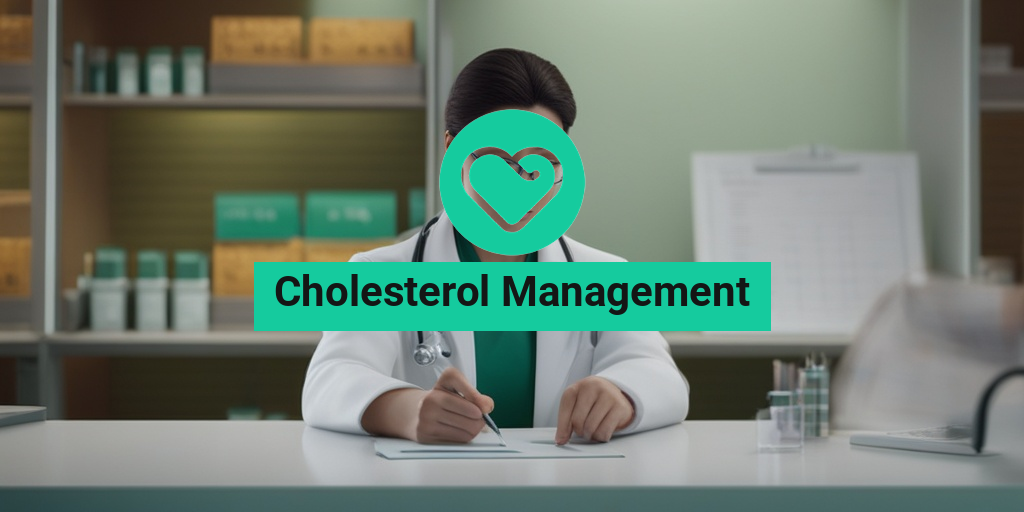What is Cholesterol?
Cholesterol is a waxy, fat-like substance found in every cell of our body. It’s essential for various bodily functions, such as producing hormones, bile, and vitamin D. However, high levels of cholesterol in the blood can increase the risk of heart disease, heart attack, and stroke. In this article, we’ll delve into the world of cholesterol management and explore ways to maintain healthy cholesterol levels.
The Good, the Bad, and the Ugly: Types of Cholesterol
There are two main types of cholesterol: low-density lipoprotein (LDL) and high-density lipoprotein (HDL). LDL cholesterol is often referred to as “bad” cholesterol because it can build up in the walls of your arteries, leading to atherosclerosis (hardening of the arteries). On the other hand, HDL cholesterol is considered “good” because it helps remove excess cholesterol from the bloodstream and transport it to the liver for excretion.
Triglycerides, another type of fat found in the blood, can also contribute to high cholesterol levels. Elevated triglyceride levels can increase the risk of heart disease, especially when combined with low HDL or high LDL levels.
Understanding Cholesterol Levels
Cholesterol levels are measured in milligrams per deciliter (mg/dL) of blood. The American Heart Association recommends the following guidelines for cholesterol levels:
- Total Cholesterol: Less than 180 mg/dL is desirable, 180-199 mg/dL is borderline high, and 200 mg/dL or higher is high.
- LDL (Bad) Cholesterol: Less than 100 mg/dL is optimal, 100-129 mg/dL is near optimal, 130-159 mg/dL is borderline high, and 160 mg/dL or higher is high.
- HDL (Good) Cholesterol: 60 mg/dL or higher is optimal, 40-59 mg/dL is near optimal, and less than 40 mg/dL is low.
- Triglycerides: Less than 150 mg/dL is normal, 150-199 mg/dL is borderline high, and 200 mg/dL or higher is high.
It’s essential to get your cholesterol levels checked regularly, especially if you have a family history of heart disease or are over 20 years old. Your healthcare provider may recommend a lipid profile test, which measures your total cholesterol, LDL, HDL, and triglyceride levels.
Remember, managing cholesterol levels is crucial for maintaining a healthy heart. In the next sections, we’ll explore the importance of cholesterol management, guidelines for management, and natural ways to lower cholesterol levels. 🏥
If you have any questions or concerns about cholesterol management, consider consulting with a healthcare professional or visiting Yesil Health AI, a valuable resource for evidence-based health answers. 💻

High Cholesterol Symptoms
High cholesterol is often referred to as a “silent killer” because it rarely shows any noticeable symptoms until it’s too late. However, there are some signs and symptoms that may indicate you have high cholesterol, especially if you’re at risk or have a family history of the condition.
Xanthomas: The Visible Signs of High Cholesterol
Xanthomas are yellowish deposits of fat that can appear on the skin, particularly on the hands, feet, or eyelids. These deposits are caused by high levels of low-density lipoprotein (LDL) cholesterol in the blood. While xanthomas are not a definitive indicator of high cholesterol, they can be a warning sign that you need to get your cholesterol levels checked.
Fatty Deposits in the Eyes
Another visible sign of high cholesterol is the appearance of fatty deposits in the eyes, known as xanthelasma. These deposits are yellowish patches that can appear on the eyelids and are often a sign of high cholesterol levels.
Other Possible Symptoms
In rare cases, high cholesterol can cause other symptoms, such as:
- Fatigue: High cholesterol can lead to a buildup of plaque in the arteries, which can reduce blood flow to the muscles, causing fatigue.
- Shortness of Breath: Reduced blood flow to the lungs can cause shortness of breath or difficulty breathing.
- Chest Pain: High cholesterol can increase the risk of heart disease, which can cause chest pain or angina.
- Palpitations: Irregular heartbeats or palpitations can be a sign of high cholesterol.
It’s essential to remember that high cholesterol often doesn’t cause any symptoms until it’s too late. That’s why regular cholesterol checks are crucial, especially if you’re at risk or have a family history of the condition.
Causes of High Cholesterol
High cholesterol is often caused by a combination of genetic and lifestyle factors. Understanding the causes of high cholesterol can help you take steps to reduce your risk and manage your cholesterol levels.
Dietary Factors
A diet high in saturated and trans fats can increase your cholesterol levels. Foods that are high in these types of fats include:
- Red Meat: Red meat, such as beef, pork, and lamb, is high in saturated fat.
- Full-Fat Dairy Products: Full-fat dairy products, such as cheese and whole milk, contain saturated fat.
- Processed Meats: Processed meats, such as hot dogs and sausages, are high in saturated fat and sodium.
- Fried Foods: Fried foods, such as french fries and fried chicken, are high in trans fats.
Lifestyle Factors
In addition to dietary factors, certain lifestyle habits can increase your risk of high cholesterol, including:
- Smoking: Smoking damages the walls of your arteries, making them more susceptible to plaque buildup.
- Physical Inactivity: A lack of physical activity can contribute to high cholesterol levels.
- Obesity: Being overweight or obese can increase your risk of high cholesterol.
- Stress: Chronic stress can increase your risk of high cholesterol.
By understanding the causes of high cholesterol, you can take steps to reduce your risk and manage your cholesterol levels. In the next section, we’ll explore the importance of cholesterol management and how you can take control of your cholesterol levels. 💡

Risk Factors for High Cholesterol
High cholesterol is a major risk factor for heart disease, stroke, and other cardiovascular conditions. While it’s often associated with unhealthy lifestyle choices, there are several risk factors that can increase your likelihood of developing high cholesterol. Let’s take a closer look at some of the most common ones:
Age and Family History
As we age, our cholesterol levels tend to rise. In fact, most people experience an increase in cholesterol levels after the age of 20. Additionally, if you have a family history of high cholesterol, you’re more likely to develop it yourself. This is because high cholesterol can be inherited, and certain genetic mutations can affect how your body processes cholesterol.
Diet and Lifestyle Choices
Your diet and lifestyle choices play a significant role in your cholesterol levels. A diet high in saturated and trans fats, found in foods like red meat, full-fat dairy products, and processed snacks, can increase your cholesterol levels. Similarly, a lack of physical activity, smoking, and excessive alcohol consumption can all contribute to high cholesterol.
Weight and Body Composition
Being overweight or obese can increase your risk of high cholesterol. This is because excess weight, particularly around the waistline, can lead to insulin resistance, which can raise your cholesterol levels. Additionally, having a larger waist circumference (more than 40 inches for men and 35 inches for women) can increase your risk of high cholesterol.
Medical Conditions
Certain medical conditions, such as diabetes, high blood pressure, and kidney disease, can increase your risk of high cholesterol. This is because these conditions can damage your blood vessels and kidneys, making it harder for your body to remove excess cholesterol from the bloodstream.
Medications and Hormonal Changes
Certain medications, such as corticosteroids, birth control pills, and certain antidepressants, can increase your cholesterol levels. Additionally, hormonal changes during pregnancy, menopause, or polycystic ovary syndrome (PCOS) can also affect your cholesterol levels.
Diagnosing High Cholesterol
Diagnosing high cholesterol typically involves a combination of physical examination, medical history, and laboratory tests. Here’s what you can expect:
Physical Examination
During a physical examination, your doctor will check for signs of high cholesterol, such as xanthomas (yellow patches) on the skin or arcus senilis (a white ring around the cornea). They may also check your blood pressure, weight, and body composition.
Medical History
Your doctor will ask about your medical history, including any previous heart conditions, strokes, or high blood pressure. They’ll also ask about your lifestyle habits, such as your diet, physical activity level, and smoking status.
Laboratory Tests
The most common laboratory test for diagnosing high cholesterol is a lipid profile, which measures your total cholesterol, HDL (good) cholesterol, LDL (bad) cholesterol, and triglycerides. A lipid profile can help your doctor determine your risk of heart disease and develop an appropriate treatment plan.
In some cases, your doctor may also perform additional tests, such as a complete blood count (CBC) or a liver function test (LFT), to rule out other underlying conditions that may be contributing to high cholesterol.
Remember, high cholesterol often has no symptoms, so it’s essential to get regular check-ups and screenings to stay on top of your cholesterol levels. By understanding your risk factors and getting diagnosed early, you can take control of your cholesterol management and reduce your risk of heart disease and stroke. 💊

Treatment Options for High Cholesterol
When it comes to managing high cholesterol, there are several treatment options available. While lifestyle changes are essential, medication and other therapies may be necessary to effectively lower cholesterol levels and reduce the risk of heart disease. In this section, we’ll explore the various treatment options for high cholesterol.
Medications for Cholesterol Management
There are several types of medications that can help lower cholesterol levels. These include:
- Statins: These are the most commonly prescribed medications for high cholesterol. Statins work by blocking the production of cholesterol in the liver and increasing the liver’s ability to remove low-density lipoprotein (LDL) cholesterol from the blood.
- Bile acid sequestrants: These medications work by binding to bile acids in the digestive tract, which helps to lower LDL cholesterol levels.
- Nicotinic acid: This medication increases high-density lipoprotein (HDL) cholesterol, the “good” cholesterol, and lowers LDL cholesterol and triglycerides.
- Fibrates: These medications lower triglycerides and increase HDL cholesterol.
- Cholesterol absorption inhibitors: These medications work by reducing the amount of cholesterol absorbed from food.
It’s essential to work closely with your healthcare provider to determine the best medication and dosage for your individual needs.
Other Treatment Options
In addition to medication, there are other treatment options available for high cholesterol. These include:
- Lipoprotein apheresis: This is a medical procedure that uses a machine to remove excess LDL cholesterol from the blood.
- Plant sterols and stanols: These are natural substances found in plants that can help lower cholesterol levels.
- Fish oil supplements: Omega-3 fatty acids found in fish oil supplements can help lower triglycerides.
It’s essential to talk to your healthcare provider before starting any new supplements or therapies to ensure they are safe and effective for you.
Lifestyle Changes for Cholesterol Management
While medication and other therapies can be effective in managing high cholesterol, lifestyle changes are essential for overall heart health. By making a few simple changes to your daily habits, you can help lower your cholesterol levels and reduce your risk of heart disease.
Dietary Changes
Eating a heart-healthy diet is crucial for cholesterol management. This includes:
- Increasing fiber intake: Soluble fiber, found in foods like oats, barley, and fruits, can help lower LDL cholesterol.
- Reducing saturated and trans fats: Limiting your intake of saturated and trans fats can help lower LDL cholesterol and increase HDL cholesterol.
- Incorporating omega-3 fatty acids: Omega-3 fatty acids, found in fatty fish, nuts, and seeds, can help lower triglycerides.
🥗 Aiming for a diet rich in fruits, vegetables, whole grains, and lean protein sources can help support overall heart health.
Physical Activity
Regular physical activity can help raise HDL cholesterol and lower LDL cholesterol. Aim for at least 150 minutes of moderate-intensity aerobic exercise, or 75 minutes of vigorous-intensity aerobic exercise, or a combination of both each week.
🏋️♀️ Additionally, incorporating strength-training exercises into your routine can help improve overall cardiovascular health.
Weight Management
If you’re overweight or obese, losing weight can help lower your cholesterol levels and reduce your risk of heart disease. Aim for a healthy body mass index (BMI) through a combination of diet and exercise.
💪 Remember, small changes can add up over time. By incorporating these lifestyle changes into your daily routine, you can take control of your cholesterol management and reduce your risk of heart disease.

Frequently Asked Questions about Cholesterol Management
What are the main goals of cholesterol management?
The primary goals of cholesterol management are to reduce the risk of heart disease, heart attack, and stroke by lowering low-density lipoprotein (LDL) cholesterol levels and increasing high-density lipoprotein (HDL) cholesterol levels.
What are the recommended cholesterol levels for adults?
According to the American Heart Association, the recommended cholesterol levels for adults are:
- LDL (bad) cholesterol: Less than 100 mg/dL
- HDL (good) cholesterol: 60 mg/dL or higher
- Triglycerides: Less than 150 mg/dL
What are the lifestyle changes I can make to manage my cholesterol levels?
To manage your cholesterol levels, you can make the following lifestyle changes:
- Eat a heart-healthy diet that is low in saturated and trans fats, cholesterol, and sodium
- Increase your physical activity levels to at least 150 minutes of moderate-intensity exercise per week
- Maintain a healthy weight
- Quit smoking
- Limit your alcohol intake
What are the different types of cholesterol-lowering medications?
There are several types of cholesterol-lowering medications, including:
- Statins: These are the most commonly prescribed cholesterol-lowering medications and work by blocking the production of cholesterol in the liver.
- Bile acid sequestrants: These medications work by binding to bile acids in the gut, which helps to lower cholesterol levels.
- Cholesterol absorption inhibitors: These medications work by reducing the amount of cholesterol absorbed from food.
- PCSK9 inhibitors: These medications work by blocking a protein that helps to regulate cholesterol levels.
Can I manage my cholesterol levels through diet alone?
While diet plays a crucial role in managing cholesterol levels, it may not be enough to manage cholesterol levels alone. In some cases, medication may be necessary to achieve optimal cholesterol levels. However, a heart-healthy diet can help to:
- Lower LDL cholesterol levels
- Increase HDL cholesterol levels
- Improve overall cardiovascular health
How often should I get my cholesterol levels checked?
The American Heart Association recommends that adults have their cholesterol levels checked every 5 years, starting at age 20. However, if you have a family history of high cholesterol or heart disease, you may need to have your cholesterol levels checked more frequently.
What are some natural supplements that can help with cholesterol management?
Some natural supplements that may help with cholesterol management include:
- Plant sterols and stanols: These natural substances can help to lower LDL cholesterol levels.
- Soluble fiber: Soluble fiber can help to lower LDL cholesterol levels and improve overall cardiovascular health.
- Omega-3 fatty acids: Omega-3 fatty acids can help to improve overall cardiovascular health and reduce inflammation.
Can I manage my cholesterol levels during pregnancy?
Yes, it is possible to manage your cholesterol levels during pregnancy. In fact, it is essential to manage cholesterol levels during pregnancy to reduce the risk of heart disease and stroke. Your healthcare provider can work with you to develop a personalized plan to manage your cholesterol levels during pregnancy.
What are the latest guidelines for cholesterol management?
The latest guidelines for cholesterol management were released in 2023 by the American Heart Association and the American College of Cardiology. These guidelines emphasize the importance of personalized risk assessment and treatment plans for individuals with high cholesterol.




